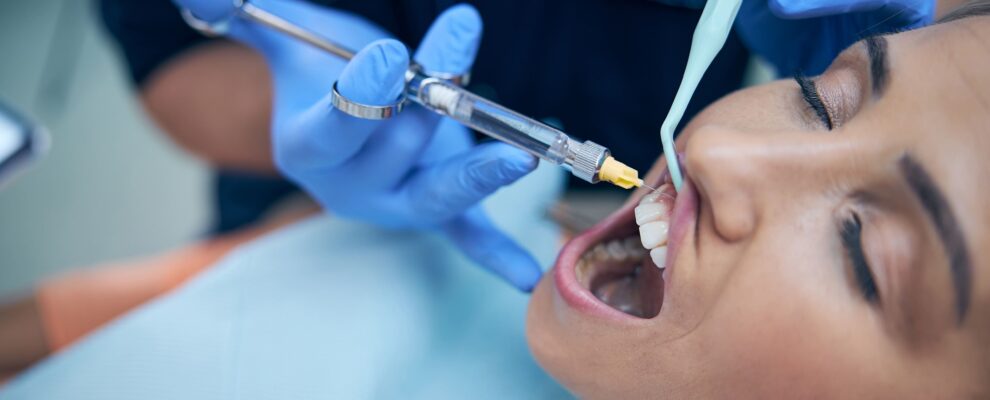Understanding Dental Anesthesia: A Guide to a Comfortable Dental Experience

Visiting the dentist can provoke anxiety in many patients, especially when it comes to procedures that may involve discomfort. To alleviate this fear and ensure a pain-free visit, various types of dental anesthesia are used. In this post, we will explore the common forms of anesthesia administered in dental care offices, addressing common concerns and questions about safety, types of procedures they’re suitable for, administration methods, and the post-procedure recovery process.
Understanding the different types of anesthesia available can help you make informed decisions and head into your dental appointment with confidence, knowing you’ll have a comfortable and anxiety-free experience.
Types of Dental Anesthesia and Their Uses
There are a variety of types of anesthesia commonly used by dentists to help patients have a comfortable and anxiety-free experience during their procedure. Depending on the type of work being done, we may use local anesthesia to numb the area, or we may opt for nitrous oxide for more extensive work. IV sedation and oral conscious sedation are options that are generally used for longer or more complicated procedures, or for patients who have particularly high anxiety levels.
Let’s explore the various types of commonly used dental anesthesia, including how they’re administered and recovery times.
Nitrous Oxide
Commonly known as “laughing gas,” nitrous oxide is used to help ease anxiety and pain during dental procedures. It’s administered via a mask placed over the nose, and the calming effects are felt within minutes. Nitrous oxide is appropriate for procedures ranging from routine cleanings to more extensive work like fillings and extractions. The gas leaves the body quickly after the mask is removed, allowing most patients to drive themselves home afterward.
IV Sedation
IV sedation, or intravenous sedation, involves administering a sedative drug through a vein. It induces a state of deep relaxation and a feeling of not being bothered by what’s happening around you. The depth of sedation can vary, and while some patients may fall asleep, they can still be awakened and will generally breathe on their own. This type of anesthesia is often reserved for lengthy procedures, such as wisdom tooth extractions or complex surgeries. Recovery takes a bit longer; you will need someone to drive you home and should plan to rest for the remainder of the day.
Local Anesthesia
With local anesthesia, a specific area of the mouth is numbed for surgery or other procedures without affecting consciousness. This is typically done through an injection near the site of the procedure and is suitable for fillings, root canals, or crown preparations. Recovery from local anesthesia is usually quick, with numbness wearing off in a few hours. Patients can resume normal activities right away.
Oral Conscious Sedation
This method involves taking a prescription medication orally before the dental procedure. The sedative pill helps patients to relax and may even make them a bit drowsy, though they will remain awake and able to communicate. This type of sedation is often used for patients experiencing anxiety or for procedures that take more time. Recovery is generally straightforward, but patients need someone to drive them home and should not operate heavy machinery for 24 hours.
Dental Anesthesia FAQs: Answering Your Concerns
Here are some answers to common questions that patients have a bout dental anesthesia:
Is dental anesthesia safe?
Yes, when administered by experienced dental professionals, dental anesthesia is considered safe for patients of all ages.
Does dental anesthesia cause patients to lose consciousness?
Only in cases of general anesthesia, which isn’t covered here, would a patient lose full consciousness. With sedation methods like IV sedation and oral conscious sedation, you may feel sleepy but will not be completely unconscious.
How long is the recovery process?
Recovery varies by type. For nitrous oxide, it’s nearly immediate. Local anesthesia wears off after a few hours. Oral conscious sedation and IV sedation require a longer recovery time and you should avoid heavy machine operation for at least 24 hours.
Ensuring Your Comfort
The goal of all types of dental anesthesia is to make your experience as easy and comfortable as possible. Talk to your dental care provider about what type of anesthesia is best suited for your upcoming procedure, any health concerns you have, and your comfort level. Armed with this knowledge, you can go into your dental appointment with more peace of mind and less anxiety.
Remember, your dental health professionals at Hilltop Dental Studios are here to guide you through the process and ensure the safest, most effective methods for a pain-free and anxiety-free dental visit. Now that you’re acquainted with the world of dental anesthesia, you can approach your next dental procedure with confidence and ease.
If you have any questions about dental anesthesia and what may be used for your upcoming procedure, don’t hesitate to ask your dental team at Hilltop Dental Studios. It is important that you understand all aspects of your experience, and we will do everything we can to address your concerns and provide a pain- and stress-free procedure.
